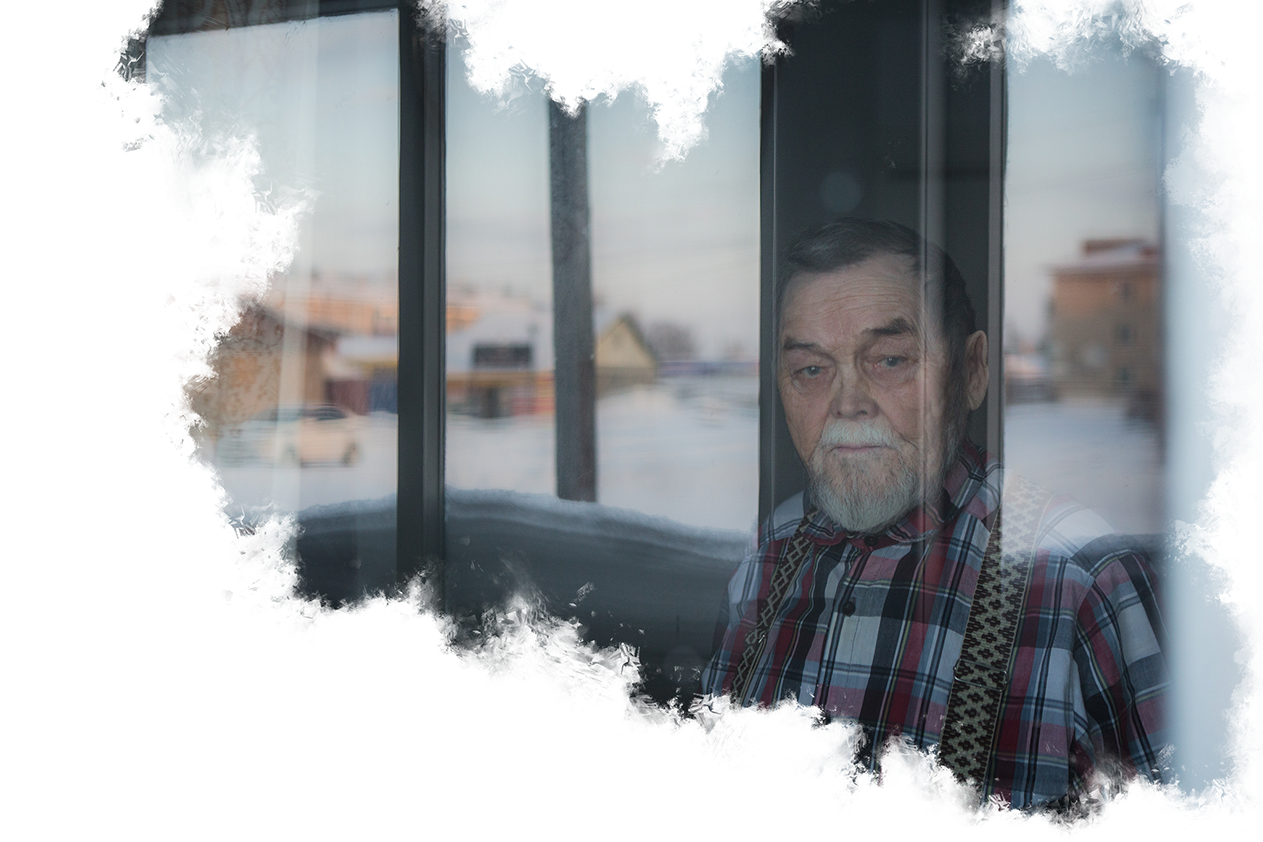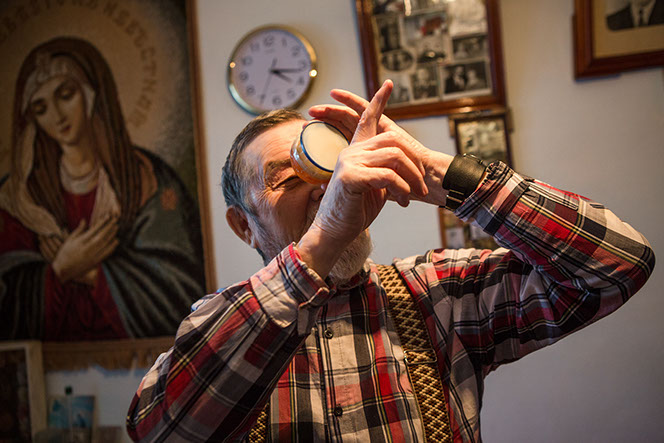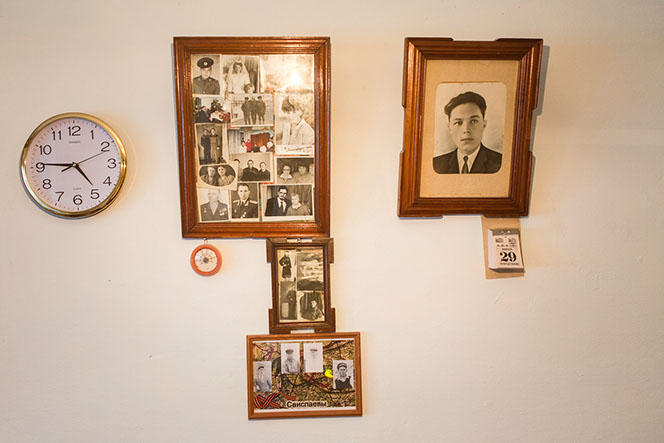
Only lovers
left alive
Georgy Saispaev, a representative of the biggest Selkup family, on living like in a movie and the reasons why he does not regret the Selkups extinction
en
The Selkups:
save as...
About
the Project
CONTEXT
TRADITIONS
TROUBLES
here is a Saispaev family tree on one of the walls of the community center between some voodoo books and some textbooks on the Selkup culture. It includes more than a hundred names. This family used to be one of the biggest and the richest among the Ostyaks (the other name for the Selkups — translator’s note), and it is still possible to find more than a dozen people with the last name Saispaev in the phonebook of Parabel’. The senior representative of the richest Selkup family lives in a three-storey pre-engineered block of flats. You’d better gather in your stomach to get inside as the front door is open for just 40 cm. It is impossible to open it wider because of ice frozen over the asphalt. We are approaching the house passing by a menswear store named Pizhon (stands for fancy pants in English — TN). On one of the walls of the flat, there is a picture of another Mr. Fancy Pants, 25-year-old Georgy Saispaev, who is watching over us from it voluptuously.
text:
Galina Sakharevich
photo:
Alena Kardash,
Natalia Bochkova
T

Georgy Arsent'evich looks
at a photo on which
he dressed in a fashionable draped coat standing
on the Red Square
in Moscow.
80-year-old Arsent’evich (in Russian, it is typical to call senior people by their patronymics — TN) is wearing a red plaid shirt and tracksuit trousers with garters. His handshake is tough.
— You’re funny guys, how come you thought of the Ostyaks? — he asks.
Georgy Arsent’evich sits down; his scarlet blanket matches the color of his shirt. Arsent’ich laughs with his toothless mouth and gets offended if we call him dedushka (an affectionate term for an “old man”). Also, he tells about his old folks.
The Saispaev family has been known since Yermak times. According to Arsent’ich's grandfather, Yermak's Conquest of Siberia painted by Surikov is virtually devoted to their ancestors. In this painting, the Ostyaks armed with thin arrows are opposing the canons of Yermak's accomplices. However, it was the Ostyaks who beat Yermak.
n the 19th century, Varfolomey Ivanovich, Arsent’ich's grandfather, founded the village of Saispaevo. The Saispaev family would go to Tomsk three times during the winter to deliver sturgeon, sterlet, and fur by carts.
— Whatnot did we bring there! — Arsent’ich exclaims, — Our family was called bourgeois.
The Russian used to say that the Ostyaks were scruffy-looking. In all photos, Georgy Saispaev has a perfect beard as if it was done in a barbershop and is wearing a soft single-breasted overcoat and fashionable glasses
During the Soviet times, a lot of settlers such as political and criminal prisoners were exiled to Saispaevo. Locals were gossiping that in one of the villages, newcomers had cut off a local woman's head. So, the Ostyaks decided to leave. They moved to the Tym river but didn't settle in as the climate, which is vital for people living in close connection with the nature, changed. Scurvy affected them and the Saispaevs realized that they were not able to live on the Tym river so they had to go back to Saispaevo.
When it was 10 versts (a Russian unit of distance equal to 1.067 kilometers — TN) left to Saispaevo, it got dark so they stopped to stay overnight, and then just started to build dwellings and stayed to live, — Georgy Arsent’evich tells his family story, which sounds as if it were a fairytale.
They didn't come back to the same place and founded another village, Nel’mach, where Arsent’ich was born. He remembers how his grandma made him swallow bitter bear bile instead of pills, tells that his mother and father were contemporaries of shamans. His parents, who were illiterate and could only scrawl their signatures, used to ask their children not to speak the Ostyak language as it was such a tongue-twister. As the language was lost, the Ostyak traditions and customs were not transmitted to the next generation. Saipaevo, the village of Arsent’ich’s ancestors, doesn't exist now.
Georgy Arsent’evich takes his passport out of his calico purse for documents. He asks us to find the word “Ostyak”. In the internal Russian passport there is no ethnicity field, thus, there’s no note “Ostyak”. Then Arsent’ich goes looking for his birth certificate. There he finds the word “Ostyak” and the soft female form “Ostyatka” next to his parents' names.
In the Soviet Union, the passport had to contain the nationality. The line showing national affiliation
in the document was called “The Fifth Line”. This expression still means an indication of nationality as
a fact of belonging to a certain ethnic community.



— I was as important as a political commissar, — says Arsent’ich, — If it was necessary to hold a meeting and make people come there, they would definitely ask me to show some film.
This is Saispayev’s birth certificate containing the “Ostyak” note.
These are the parents of Georgy Arsent'evich in the village of Nelmach, which his grandfather founded.

Georgy Arsent'evich with his wife.
The Russians used to say that the Ostyaks were untidy. That's probably the reason why Grigory Arsent’evich's flat is perfectly tidy, and he does all housework alone. The Russian used to say that the Ostyaks were not very intelligent. Georgy Arsent’evich quotes scientific works by Marx, poems by Pushkin, and lines from Belinsky; his deskbook is a big encyclopedia. The Russian used to say that the Ostyaks were scruffy-looking. In all photos, Georgy Saispaev has a perfect beard as if it was done in a barbershop and is wearing a soft single-breasted overcoat and fashionable glasses. Russian people used to think that Ostyak women were not beautiful. Saispaev calls his first wife Marilyn Monroe.
— The Ostyaks were hu-mi-li-a-ted, — Arsent’evich tells us pressing his lips together bitterly.
He didn’t have any problems at school: Arsent’evich studied at boarding school for the Indigenous People of the North, where there were only the Ostyaks. Though, as Georgy Saispaev continues telling, “in the army, they knew somehow that I was Ostyak and bullied me.”
— I didn't say anything opposing that as it wasn't possible to change everyone's minds, — Georgy Arsent’ich says.
After the army, his main dream to enter the Institute of the Peoples of the North in Leningrad (Saint-Petersburg’s name during Soviet times — TN) could have come true. But in the post-war period, there was enough money only to send his elder brother to study.
Georgy worked in hunting and fishing communities, whose owner made them go 40 km down to taiga. His brother would send photos of him standing in front of the cruiser Aurora and on the Palace square. Georgy decided that if he couldn't go to the university, he needed a winning profession. After finishing his studies in Novosibirsk, Georgy Saispaev became the first cinema operator in the district.
— It was a top job. I came to the village and everything came to life.
A boarding school for the people of the north. It existed in Tomsk Oblast until 1979. After the school was closed, the Selkup children attended regular school together with children of other nationalities.

The Saispaev family tree
is typical for a Selkup family.
He was the first to show films to the villagers of his district. The villagers had their own experience of The Arrival of a Train for 20 kopeks (1/100 of Russian ruble — TN): they got scared when firing cannons appeared on the screen and cried over soap operas.
— I was as important as a political commissar, — says Arsent’ich, — If it was necessary to hold a meeting and make people come there, they would definitely ask me to show some film.
Finally, everybody forgot his being Ostyak or “a second-class person” in the opinion of some Russians. Finally, he became not only equal to everybody, but a big fish in a little pond.
When he used to walk across the village with bobbins, boys and girls who were in love with him followed him everywhere.
— People said I was a good-looking guy, it’s now when I look ugly! — Saispaev laughs.
This is just the process of evolution. We should have thought of preservation when there was something to preserve
His domain included eight villages. Eight villages — eight loving girls. They knew about each other but couldn't resist a motion picture operator. Georgy showed passionate scenes from And Quiet Flows the Don to the villagers, and then kissed in his film booth on the stage. Depending on the number of films he brought, Georgy Saispaev usually had one to three days of love. And then the same happened in the following village.
— They were like angels, — Arsent’ich recalls.
Nowadays, if he goes to the shop, people call him dedushka. It is extremely offensive for Georgy Arsent’ich, who was a handsome man. A photo of him with his wife, who died 14 years ago, is the only reminder of his big love. He calls her honeypie. Next to the family photos on the wall, there is a wall hanging depicting the Virgin Mary. Georgy Arsent’evich doesn't believe in god, he believes in socialism, and in the kitchen he has a reproduction of picture “Stalin and Beria” (Stalin was the Soviet ruler in 1924–1953; Beria was a Soviet politician, the chief of the Soviet security and secret police apparatus under Stalin in WWII — TN). The wall hanging is a present given to his wife a year before her death.
The senior representative of the Saispaev family line doesn't have any children.
— Is your culture going to get extinct? — I ask him sadly.
— That's right, — Arsent’ich states the obvious calmly, — Honey, I’m myself going to die soon; now I don't care anymore. This is just the process of evolution. We should have thought of preservation when there was something to preserve.